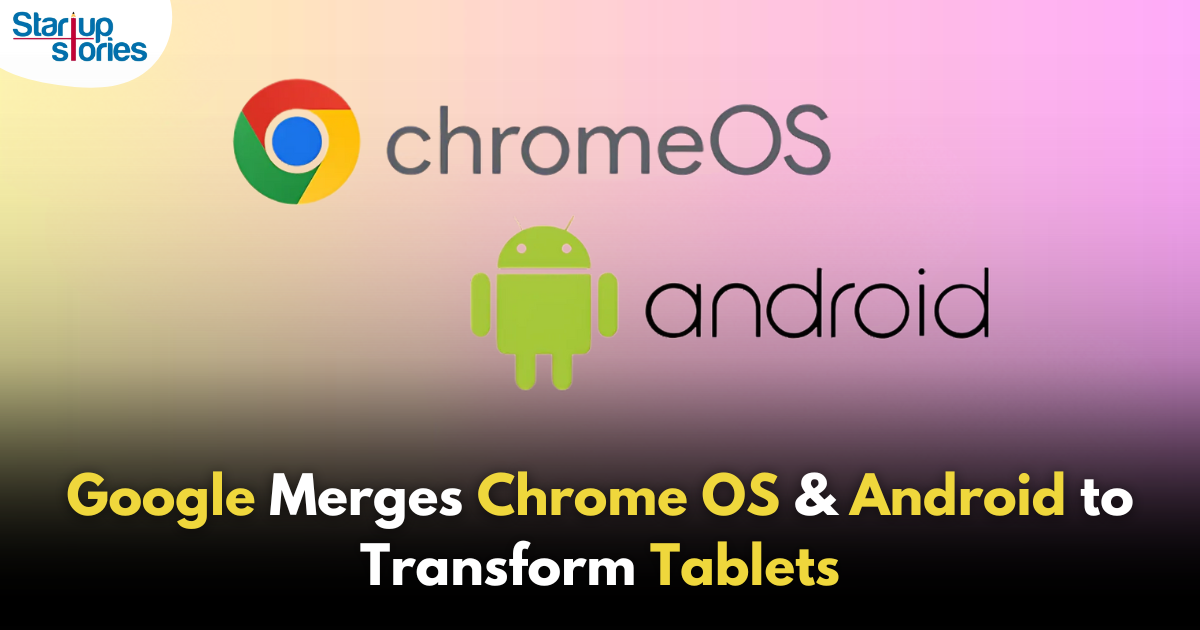Latest News
Google’s Bold Move: Transforming Chrome OS into Android to Rival Apple’s iPad!

Google, a tech giant with a strong foothold in both mobile and laptop ecosystems, has long relied on two separate operating systems: Android for smartphones and Chrome OS for laptops. While Android excels on small-screen devices, its performance on larger tablets has been less impressive. Conversely, Chrome OS, although functional, struggles with app availability, creating a gap in Google’s ability to challenge Apple’s dominance in the tablet market.
The Planned Transition
According to a recent report by Android Authority, Google is reportedly embarking on a multi-year project to merge Chrome OS with Android. While the company has not officially confirmed this move, recent updates and statements hint at a significant shift in strategy. Google has been integrating features from both systems, signaling a gradual convergence aimed at addressing their individual shortcomings.
Key Features of the Transition
- Integration of Android Components: Recent announcements revealed that Chrome OS is beginning to adopt elements of the Android stack, such as the Linux kernel and Android frameworks. This integration is intended to enhance functionality and improve user experience across devices.
- Enhanced Desktop Experience: Changes introduced in Android 15, including improved desktop windowing, enhanced keyboard and mouse support, and multiple desktops, align with the functionality needed for an Android-on-laptop experience. These features are crucial for creating a more versatile operating system that can compete effectively with iPadOS.
- New Chrome Browser for Android: Google is developing a new version of Chrome for Android that will include extension support, further bridging the gap between the two operating systems.
- Terminal Application for Linux Compatibility: The introduction of a terminal application will allow users to run Linux apps on Android, providing a Crostini-like experience similar to what Chromebooks currently offer.
Implications for Chromebook Users
If successful, this transition could redefine the Chromebook experience by allowing devices to operate more like Android-powered laptops. Future “Chromebooks” might ship with a desktop-optimized version of Android instead of Chrome OS, potentially providing access to a wider range of Android apps and creating a more touch-friendly interface suitable for convertibles and detachables.
Potential Benefits
- Increased App Availability: By merging the two platforms, Google could significantly expand the number of applications available to users, enhancing the overall ecosystem.
- Streamlined Development Resources: Unifying development efforts could lead to faster updates and feature rollouts, as resources would no longer be split between two operating systems.
- Enhanced User Experience: A combined platform could leverage the strengths of both operating systems—Android’s app ecosystem and Chrome OS’s productivity features—to create a compelling product that rivals Apple’s iPad.
Challenges Ahead
Despite these promising developments, questions remain about the future branding of Chrome OS and Chromebooks. It is unclear whether they will maintain their current identities or fully embrace the Android brand. Additionally, while Google has laid significant groundwork for this transformation, many proposed features are reportedly part of an internal “Android-on-laptop” project that may not reach consumers immediately.
Conclusion
This ambitious move highlights Google’s intent to close the gap with Apple in the tablet segment and position itself as a stronger competitor in the broader device ecosystem. By rethinking its operating systems to meet evolving user demands, Google aims to create a unified platform that enhances user engagement and satisfaction. As development continues, it will be essential to monitor how these changes unfold and what they mean for both existing users of Chrome OS and potential new customers drawn by an integrated Android experience.
Latest News
Kuku FM’s $200 Million IPO: Mebigo Labs Hires Top Bankers to Lead Public Listing

Kuku FM’s parent company, Mebigo Labs, has hired leading investment banks to prepare for a 200 million dollar IPO in India, marking a major milestone for the country’s digital audio ecosystem. The Mumbai-based company has reportedly appointed Kotak Mahindra Capital, Axis Bank and Morgan Stanley’s India unit to manage the proposed share sale, which is likely to be launched on Indian stock exchanges once key regulatory steps are completed. This move signals strong intent to tap public markets and test investor appetite for subscription-led regional audio platforms in India.
The planned IPO proceeds are expected to help Kuku FM expand its content library, strengthen its regional language offerings and invest in technology to enhance user experience. With a focus on Hindi, Marathi, Tamil and other Indian languages, Kuku FM aims to capture the fast-growing audience in Tier 2 and Tier 3 cities seeking affordable audiobooks, courses and storytelling content. The funds could also provide additional firepower for marketing, partnerships and product innovation, helping the platform compete more aggressively in India’s crowded digital entertainment and creator economy landscape.
Founded in 2018, Kuku FM has built a subscription-driven business model and has reportedly scaled to millions of paying users, backed by multiple funding rounds from prominent investors. Its decision to pursue a 200 million dollar IPO positions it as one of the first major Indian audio platforms to attempt a public listing, potentially paving the way for other podcast and niche content startups to follow. As the IPO process moves forward, Kuku FM’s performance in the public markets will be closely watched as a key indicator of how investors value regional, knowledge-first audio platforms in India’s booming digital economy.
Latest News
Zerodha Reports 23% Profit Decline in FY25 as Revenues Miss Target

Zerodha experienced a challenging FY25, as its revenue fell 11.5% to ₹8,847 crore and net profit dropped 22.9% to ₹4,237 crore. This decline reflects tougher regulatory conditions, lower trading volumes, and increased operational costs in the brokerage market, all of which impacted core earning segments for the company.
Despite these headwinds, Zerodha improved its operating margin to 63.78% and built up significant cash reserves, reporting ₹22,679 crore in bank balances. Salary expenses and director remuneration increased, but disciplined cost controls helped the company maintain profitability and a debt-free balance sheet. The drop in active clients and increased compliance costs further contributed to the profit contraction.
Looking ahead, Zerodha’s resilience is supported by its robust cash position and operational efficiency. Maintaining steady margins, diversifying product offerings, and investing in technology positions the company to withstand future regulatory fluctuations and changing market sentiment reinforcing its status as one of India’s leading brokerage firms.
Latest News
Zoho Pay Debuts as India’s New UPI Challenger, Taking on PhonePe, Paytm, and Google Pay

Zoho Corporation has expanded its fintech portfolio with the launch of Zoho Pay, a UPI-based payments app built to challenge India’s top digital payment giants such as PhonePe, Paytm, and Google Pay. The new app supports peer-to-peer transfers, bill payments, QR-based transactions, and merchant settlements in a streamlined interface. Available as both a standalone app and an integrated feature inside Zoho’s privacy-driven messenger Arattai, Zoho Pay enables users to handle chats and payments in one platform, emphasizing data privacy and Made-in-India innovation.
Through seamless integration with Arattai, Zoho Pay allows users to send or request payments, split expenses, and conduct UPI-based transactions directly in their chat windows. Users can link bank accounts, scan dynamic QR codes, and receive audio confirmations of payments, ensuring speed and security. This design mirrors the simplicity of India’s leading UPI apps but is powered by Zoho’s non-advertising, privacy-first model. The integration aligns with Zoho’s mission to build a self-reliant digital ecosystem, where messaging and money management coexist securely.
In the competitive digital payments market, Zoho Pay differentiates itself through its tight business software integration with apps like Zoho Books, Zoho Payroll, and Zoho Commerce, offering small businesses unified access to payments, billing, and accounting. The company is also expanding its reach with POS devices for merchants featuring UPI QR, card payments, and instant reconciliation tools. With founder Sridhar Vembu’s vision of a ‘Chat + Pay’ ecosystem, Zoho Pay reflects a bold step toward redefining India’s fintech scene with a secure, ad-free, and locally developed alternative to global payment platforms.










Открыть учетную запись в binance
May 22, 2025 at 6:37 am
I don’t think the title of your article matches the content lol. Just kidding, mainly because I had some doubts after reading the article. https://www.binance.com/ES_la/register?ref=T7KCZASX
fbvdp
June 6, 2025 at 3:39 am
how to get generic clomid without dr prescription get cheap clomiphene without a prescription where buy cheap clomid price where buy clomiphene cost of clomiphene without prescription can i get clomid without rx clomiphene rx for men
MM88
November 6, 2025 at 1:02 pm
Với giao diện mượt mà và ưu đãi hấp dẫn, MM88 là lựa chọn lý tưởng cho các tín đồ giải trí trực tuyến.
Kuwin
November 8, 2025 at 5:25 am
kuwin sở hữu kho game đa dạng từ slot đến trò chơi bài đổi thưởng, mang đến cho bạn những giây phút giải trí tuyệt vời.
谷歌蜘蛛池
November 10, 2025 at 7:14 am
利用强大的谷歌蜘蛛池技术,大幅提升网站收录效率与页面抓取频率。谷歌蜘蛛池
谷歌外推
November 12, 2025 at 9:00 pm
采用高效谷歌外推策略,快速提升网站在搜索引擎中的可见性与权重。谷歌外推
GO88
November 19, 2025 at 1:32 pm
Tham gia cộng đồng game thủ tại Go88 để trải nghiệm các trò chơi bài, poker phổ biến nhất hiện nay.
iwin
November 26, 2025 at 7:04 am
iwin – nền tảng game bài đổi thưởng uy tín, nơi bạn có thể thử vận may và tận hưởng nhiều tựa game hấp
MM88
November 29, 2025 at 4:57 pm
Khám phá thế giới giải trí trực tuyến đỉnh cao tại MM88, nơi mang đến những trải nghiệm cá cược thể thao và casino sống động.
1win
December 12, 2025 at 11:44 am
https://t.me/s/be_1win/770
AtomCasino
December 13, 2025 at 12:46 pm
https://t.me/s/atom_official_casino
kazino_s_minimalnym_depozitom
December 19, 2025 at 2:26 pm
https://t.me/s/Kazino_s_minimalnym_depozitom